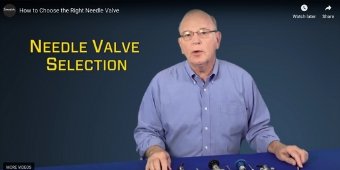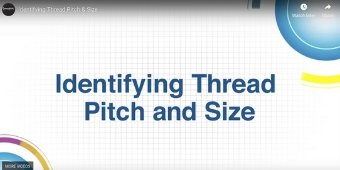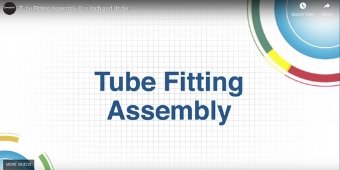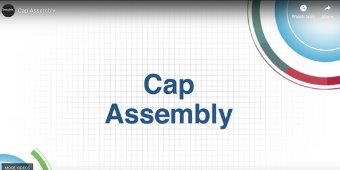Engineering Services
Product Lines
Resources
About
Shop
Swagelok Northern California
Videos on assembly, installation, identification, product features, tools, and related topics.
%20(1).png)
In this video, we give a quick overview of the four components of a hose and discuss how to select a hose in four steps.
/36.jpg)
Learn about properties and uses for Swagelok PB Series Rubber Hose, as well as push-on hose end connections and hose clamps.
%20(1).png)
Learn about the unique non-metallic fiber braiding technology that gives the PTFE core greater resistance to collapsing and kinking when being bent.
/Resources%20-%20Tombstones%20(27)%20(1).png)
In this 2016 clip we explore the three steps involved in installing a Swagelok tube fitting and common installation errors.
/Resources%20-%20Tombstones%20(29)%20(1).png)
Cracking pressure is that pressure in which you first get an indication of flow. Re-seal typically requires back pressure in order to re-seal properly.
/Resources%20-%20Tombstones%20(30)%20(1).png)
Did you know that flow capacity is a matter of pressure drop? Pressure drop in turn is influenced by factors including the viscosity of the fluid, the temperature or pressure that’s applied, and the length and characteristics of your tubing or hose.
/Resources%20-%20Tombstones%20(28)%20(1).png)
Brush up on the components of a Swagelok tube fitting, and how important you are to the proper installation of a Swagelok tube fitting.
/Resources%20-%20Tombstones%20(25)%20(1).png)
How to make a very strong four-port manifold of traditional size, or one that’s about 30% shorter (for tight spaces).
/54.jpg)
Learn about options like all-metal, PFA core, PTFE core, and nylon core; available from two-inch down to 1/8 inch, with a wide variety of end connections.

Using the Swagelok Bench Top Tube Bender; how to make accurate bends in tubing of various materials, diameters.

How to prep tube ends for leak free tube fitting connections; cutting, deburring, cleaning, inspecting.

How to choose the right Swagelok needle valve; differences between general service and severe service valves.
/53.jpg)
Where to check surface finish, material, hardness, wall thickness, suggested allowable working pressures, products for elevated temperatures, and more.

How to fix alignment problems with positionable elbows and tees; use with O-rings and with aluminum threads.

How to prevent accidental intermixing of multiple lines with keyed quick connects; get a positive interaction of valve.

How to get leak free metal-to-metal connections.

Steps in coning and threading a tube end; how to install a Swagelok cone and thread fitting.

How to identify thread pitch and size (covers tapered & parallel).

In this 2012 clip we show how to assemble Swagelok tube fittings—one inch and smaller.

How to assemble and install a Swagelok cap to block off the end of a tube run.

How to apply SWAK anaerobic thread sealant to a fitting; get reliable seals on metal pipe threads.

How to apply PTFE tape on male tapered pipe threads; get leak free connections with right technique.

How to flatten regulator flow curves to minimize droop; keep pressure constant as flow changes.

How to choose the right Swagelok hose end connection for your process (or get local help).

How to use a Swagelok Hand Tube Bender—what to know before operating the bender.

What Supply Pressure Effect is and how to manage a Swagelok regulator's SPE (Part 1 of 2).

What Supply Pressure Effect is and how to manage a Swagelok regulator's SPE (Part 2 of 2).
/34.jpg)
Find hose and flexible tubing products for a variety of fluid handling system needs – 22 different hose types and 89 different end connections.
/Resources%20-%20Tombstones%20Swagelok%20Stream%20Selector%20System%20for%20Process%20Analyzer%20Applications%E2%80%94SSV%20Series%20(1).png)
The Swagelok stream selector system (SSV series) is a modular assembly designed for process analyzer sampling systems that provides double-block-and-bleed (DBB) operation in a single compact module.
/KEV%20Series%20Regulators%20-%20Heated%20Regulators%20Reacting%20to%20Changes%20in%20Thermal%20Load%20(1)%20(1)%20(1).png)
Learn about the KEV Series regulator’s integral control that enables quick response to deviations from system conditions.
/12.jpg)
General use for liquid sampling. Purge option (using gas or a solvent) clears fluid before and/or after sample collection.
/Resources%20-%20Tombstones%20(14)%20(1).png)
Ball valves offering low-torque, quarter-turn operation in a compact design with positive shutoff up to 6000 psig (413 bar).
/Resources%20-%20Tombstones%20(15)%20(1).png)
AFS ball valves meeting critical needs in the compressed natural gas and hydrogen fuel industries.
%20(1).png)
Swagelok’s new DPX and DFX replaceable-seat diaphragm valves leverage the design of our flagship DP and DF springless diaphragm valves used primarily in ultra-high purity applications.
/Resources%20-%20Tombstones%20(17)%20(1).png)
Swagelok’s DPX and DFX replaceable-seat diaphragm valves have the same high-performance seat seal as traditional DP and DF springless diaphragm valves, but with a replaceable seat. In this video, learn about its innovative design and how to easily, repeatedly and reliably replace the seat.
/49.jpg)
A side-load installation tool enables you to remove the side-load retainer gasket and install it without touching it.
/2.jpg)
Make repeatable orbital gas tungsten arc welds for tubing and pipe. Monitoring and recording make documentation easy.
/Resources%20-%20Tombstones%20(18)%20(1).png)
Using the Push-on Tool in assembly of swaged hose assemblies.
/30.jpg)
Using the MHSU to pre-swage a set of ferrules to specific tubing sizes.
/39.jpg)
Match stainless steel ferrules and fittings with stainless steel tubing, brass fittings and ferrules with copper tubing, and plastic fittings and ferrules with plastic tubing.
/41.jpg)
Because we hold tolerances so tight, we can predict the gap between body hex and nut. You can check for proper pull up and make adjustments accordingly.
/42.jpg)
Learn about using rebuild kits for Swagelok’s manually actuated valves and several of our remotely actuated valves to adjust or replacing the packing.
/54.jpg)
When to choose Swagelok’s rubber hose or our nylon core hose; and when to opt for one of our PTFE inner core hoses.
/45.jpg)
How to address difficult alignment positions and reduce inventory with the help of Swagelok tube adapters.
/46.jpg)
Our tools are simple to use and make precision tube cutting and smoothing easy.
/Resources%20-%20Tombstones%20(20)%20(1).png)
Learn about clamshell-style, a latch lock design, and more.
/50.jpg)
A cap is a complete tube fitting assembly used to cap tubing. A plug has machined ferrules already inside.
/51.jpg)
Get all the tools you need for cutting and bending tubing and installing Swagelok tube fittings.
Swagelok Northern California
Swagelok Northern California is a locally owned sales and service center of Swagelok, a company celebrating 75 years in business. We have locations in Fremont and Sunnyvale, CA (USA). Phone: 510-933-6200.